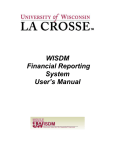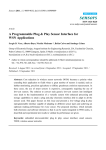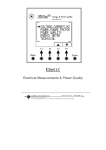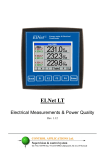Download How Do I Care for a Flash Drive?
Transcript
How Do I Care for a Flash Drive? • Do not force Flash storage devices into connectors Flash card or USB Flash drive connectors are unidirectional. This means that the Flash storage device must be inserted in one direction only; if you cannot insert the device, do not force it in to prevent damage to the Flash storage device or the socket! For more information on proper insertion of Flash cards or USB Flash drives, consult your host device's user manual. • Properly remove your Flash storage device from the host device It is important to wait until all operations are completed before removing a Flash storage device from a digital camera or other host device. If the Flash storage device is removed during a write operation, for example, the Flash storage device may be corrupted and data loss may occur. Most digital cameras will show a blinking light during Flash write operations, so it is important to wait until all operations are completed. On PCs, it is important to stop a USB connection through Windows (In Windows XP, use the "Safely Remove Hardware" icon in the system tray). Computers often "cache" data into memory and may delay the write to USB Flash drives. As a rule of thumb, wait a minimum of 2 minutes after you finish writing data to a USB drive. • Always make backups of your data Flash storage devices are not infallible and can have their data damaged due to factors mentioned above. It is important to backup important information on multiple media or even print them on paper for long-term storage. Do not store important data solely on Flash storage devices. • Properly store Flash Drives. Flash storage devices, while quite reliable, can be damaged when dropped on hard surfaces. When not in use, drives should be stored with their caps on. When carrying or transporting use the drive's original fabric package. Don't put it on your pockets or experiment with soft wrappings that allow the USB connector to fold or dirt to go through. • Static electricity can damage devices. Take care of your hands static electricity before turning the flash drive on. By default flash drives have protection against such static electricity but don't solely rely on that. For example, on dry days, a person can generate enough static electricity to cause a spark while touching a door knob or other metal objects (this is called electro-static discharge or ESD). • Flash drives store data in a memory card which is totally immune to magnetic fields. A magnet powerful enough to disturb the electrons in a flash drive would be powerful enough to suck the iron out of your blood cells. • Flash memory could be read numerous times from, but its CS 8 - 1 writing/deleting/connecting that is limited. If you don't physically ruin your drive, you have about 1,500 connections and about 10,000 read/write cycles before you can expect the USB life cycle to become questionable. Flash memory could be read numerous times from, but its writing/deleting/connecting that is limited. If you don't physically ruin your drive, you have about 1,500 connections and about 10,000 read/write cycles before you can expect the USB life cycle to become questionable. • Flash drives could lose data in devices (i.e. laptops, cameras) with a low-battery warning. Battery discharge is one of the most common problems causing the loss of pictures or other data on Flash storage devices. If a battery dies in the middle of a write operation to the Flash storage device, then not only can the file being written become corrupted, but the entire device may be damaged as well. For example, if the File Allocation Table (FAT) directory file update is incomplete and the FAT file is corrupted, some or all files on the Flash storage device may no longer be accessible. However, it may be possible to repair the Flash storage device using commercially available disk recovery software. Even with these recovery programs, some data or files on the Flash storage device may still be lost, but the rest may be recoverable. To avoid these problems, carry a spare battery if possible or stop using a device when battery power gets very low. • Avoid U.S. Postal Service radiation scanning of mailed packages. According to the Compact Flash Association, x-ray scanners at airports will not damage Compact Flash cards but radiation scanning by the U.S. Postal Service may damage them. Because of this warning by the Compact Flash Association regarding mail irradiation by the U.S. Postal Service, it may be preferable to use a commercial service such as FedEx, UPS, or other private carrier as an alternative to mailing Flash storage devices by U.S. mail. • Pack Flash storage devices into carry-on luggage if possible. Tens of millions of Flash storage devices are in use worldwide, and there have been no verifiable reports of Flash storage damage due to airport X-ray scanners. A 2004 study by the International Imaging Industry Association (I3A) verified that today's airport X-ray machines do not appear to be a risk to flash memory cards. As a precaution, Flash Drives should be treated just like unprocessed film and stored in carry-on luggage, as the passenger screening radiation levels are much lower than those used by newer luggage scanning machines. Source: This was adapted from many sources off the internet. Google enter “USB Flash Drive” in search box. CS 8 - 2








